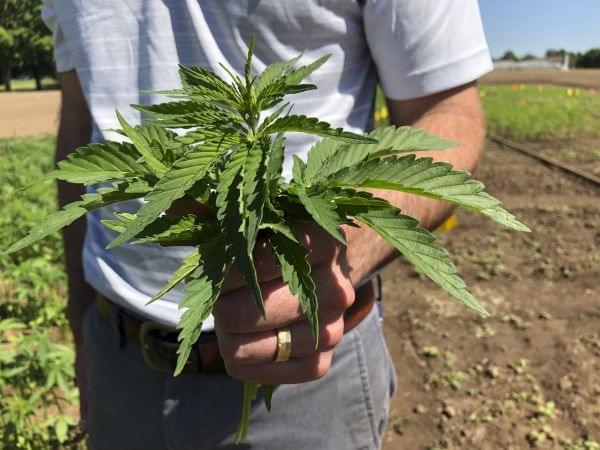Illinois Farmers Growing Hemp; Increasing Youth Suicide Rate; Meteorite At The Field Museum

A plant ecologist with the Oregon State University Extension Service, holds freshly picked tops of hemp plants from one of Oregon State's hemp research stations in Aurora, Ore. Illinois farmers have legally been able to grow hemp since April. Gillian Flaccus/AP
Illinois farmers have been growing hemp legally for the first season since the state approved production rules in April. Is this cash crop paying off for farmers? Plus, within the past decade, the death rates from suicide went up more than 50% among young people aged 10 to 24. We spoke with a psychologist and a student about what they’ve seen on the ground when it comes to teens and mental health. And, scientists at Chicago’s Field Museum are ecstatic about the latest addition to their collection of meteors. They say it’s been in almost the same condition for billions of years.
Illinois Farmers Growing Hemp
Farmers in Illinois were able to legally grow hemp — a cousin of the marijuana plant — for the first time this growing season since the state passed the Industrial Hemp Act.
Hemp has many uses, from creating fiber to the now trendy CBD oil you may have seen in health food stores. Many growers are betting that hemp could be Illinois new cash crop. The state’s corn and soybean growers faced a challenging season this year between flooding and late planting in many parts of Illinois, farm margins were tight. So how did hemp growers fare this season?
Andy Huston farms hemp in Roseville, which is about an hour west of Peoria, and is CEO of American Hemp Research.
Rachel Berry is CEO of the Illinois Hemp Growers Association, which worked to pass the industrial hemp act in the state. She has a 13 acre farm northwest of Princeton, Illinois.
"This industry is so new to Illinois," says Roseville #hemp farmer Andy Huston.
— The 21st (@21stShow) October 29, 2019
"The infrastructure hasn't gotten built up yet... it's going to be a little bit of a bumpy road." But, he says there is serious profit potential in the industry.
Increasing Youth Suicide Rate
From 2000 to 2007, the death rate from suicide in America among young people was relatively stable, according to data from the Centers for Disease Control.
But just this past month, the agency published new data, which found that this rate is changing. The CDC now says that in the most recent 10 years of data, the death rates from suicide went up more than 50% among young people aged 10 to 24.
We wanted to spend some time talking about why this might be happening, and what should be done to support young people.
We were joined by Dr. Keisha Powell. She’s an Assistant Professor of Clinical Psychiatry for Southern Illinois University Medicine in Springfield.
Devin Dionne also joined us in our Urbana studio. He’s a junior majoring in economics and finance at the University of Illinois. He’s also the Vice President of External Affairs for the U of I chapter of Active Minds, which is a peer-run mental health group. They have more than 450 chapters nationwide in high schools and colleges which focus on peer education and support for mental health.
If you or someone you know needs help, you can call the National Suicide Prevention Lifeline at 1-800-273-8255.
Across the board we don’t have enough psychiatrists or therapists... to meet the demand as we would like to, says Dr. Powell @siusom
— The 21st (@21stShow) October 29, 2019
Meteorite At The Field Museum
This past spring, a meteorite about the size of a washing machine broke apart and rained down on the central Costa Rican community of Aguas Zarcas.
And now, thanks to collaboration between residents, collectors and donors, one of the biggest pieces of that meteorite is now in Illinois at Chicago’s Field Museum. The museum already has thousands of meteorites, but scientists say this one is special.
Philipp Heck is the Robert A. Pritzker associate curator at the Chicago Field Museum joined us to talk about this latest addition, which he described as priceless.
“When we got the first piece I was really excited,” Heck of the @FieldMuseum says. “It was more pristine than other meteorites.”
— The 21st (@21stShow) October 29, 2019

